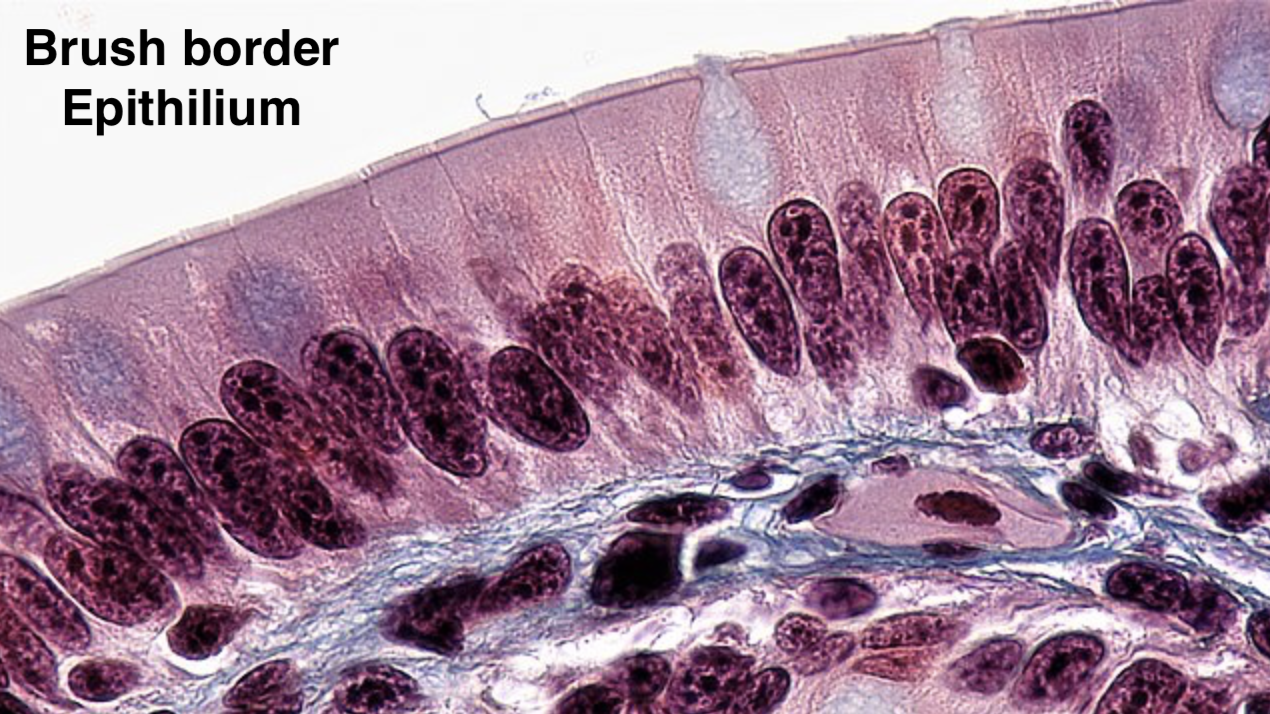
Proximal convoluted tubule (PCT) is lined with
(a) Cuboidal epithelium with brush border
(b) Cuboidal epithelium
(c) Columnar epithelium
(d) Ciliated epithelium
Answer
573.3k+ views
Hint: Epithelium is the tissue that provides lining or covering to parts of our body such as skin which is the outermost layer of the body protecting us from the outside world. Epithelium also lines the inner surface of tubular organs such as the gastrointestinal tract, fallopian tubes, etc.
Complete answer:
A nephron consists of the renal corpuscle (Bowman’s capsule) and renal tubule. Proximal Convoluted Tubule PCT is a highly convoluted tubule which is part of the renal tubule. It is situated in the cortical region of the kidney. PCT is lined by a simple cuboidal brush border epithelium as its main function is absorption and microvilli present in the brush border cells greatly enhance the surface area for absorption.
PCT absorbs all the essential nutrients, $100\%$ glucose, $70\%-80\%$ electrolytes, and water.

So, the correct option is ‘Cuboidal epithelium with brush border’.
Additional information:
Let us now look at the type of epithelium mentioned in the options.
- Cuboidal epithelium: It consists of cells that are cube- shaped and arranged in a single layer. These cells are mainly involved in secretion and absorption.
- Columnar epithelium: These cells are also arranged in a single layer and consist of tall and slender cells. They have nuclei at the base. Their main function is absorption and secretion and found in the lining of the small intestine.
- Ciliated epithelium: When columnar epithelial cells have cilia on their free end then that epithelium is known as the ciliated epithelium. These cilia help move substances in a particular direction like moving the ovum in the fallopian tubes.
Note:
- The cells of PCT contain large numbers of mitochondria. This is to meet the high energy demand that is required to actively absorb ${ Na }^{ + }$ ions from the filtrate.
- The materials that are absorbed from the filtrate move from the PCT into the interstitium and then into the peritubular capillaries and back into the blood.
- PCT helps maintain the pH and ionic balance in our body by secreting $H^{ + }$,$K^{ + }$, ${ { NH }_{ 4 } }^{ + }$ ions and absorbing ${ { HCO }_{ 3 } }^{ - }$ ions from the filtrate.
Complete answer:
A nephron consists of the renal corpuscle (Bowman’s capsule) and renal tubule. Proximal Convoluted Tubule PCT is a highly convoluted tubule which is part of the renal tubule. It is situated in the cortical region of the kidney. PCT is lined by a simple cuboidal brush border epithelium as its main function is absorption and microvilli present in the brush border cells greatly enhance the surface area for absorption.
PCT absorbs all the essential nutrients, $100\%$ glucose, $70\%-80\%$ electrolytes, and water.

So, the correct option is ‘Cuboidal epithelium with brush border’.
Additional information:
Let us now look at the type of epithelium mentioned in the options.
- Cuboidal epithelium: It consists of cells that are cube- shaped and arranged in a single layer. These cells are mainly involved in secretion and absorption.
- Columnar epithelium: These cells are also arranged in a single layer and consist of tall and slender cells. They have nuclei at the base. Their main function is absorption and secretion and found in the lining of the small intestine.
- Ciliated epithelium: When columnar epithelial cells have cilia on their free end then that epithelium is known as the ciliated epithelium. These cilia help move substances in a particular direction like moving the ovum in the fallopian tubes.
Note:
- The cells of PCT contain large numbers of mitochondria. This is to meet the high energy demand that is required to actively absorb ${ Na }^{ + }$ ions from the filtrate.
- The materials that are absorbed from the filtrate move from the PCT into the interstitium and then into the peritubular capillaries and back into the blood.
- PCT helps maintain the pH and ionic balance in our body by secreting $H^{ + }$,$K^{ + }$, ${ { NH }_{ 4 } }^{ + }$ ions and absorbing ${ { HCO }_{ 3 } }^{ - }$ ions from the filtrate.
Recently Updated Pages
The number of solutions in x in 02pi for which sqrt class 12 maths CBSE

Write any two methods of preparation of phenol Give class 12 chemistry CBSE

Differentiate between action potential and resting class 12 biology CBSE

Two plane mirrors arranged at right angles to each class 12 physics CBSE

Which of the following molecules is are chiral A I class 12 chemistry CBSE

Name different types of neurons and give one function class 12 biology CBSE

Trending doubts
One Metric ton is equal to kg A 10000 B 1000 C 100 class 11 physics CBSE

What is 1s 2s 2p 3s 3p class 11 chemistry CBSE

Discuss the various forms of bacteria class 11 biology CBSE

State the laws of reflection of light

Explain zero factorial class 11 maths CBSE

An example of chemosynthetic bacteria is A E coli B class 11 biology CBSE




